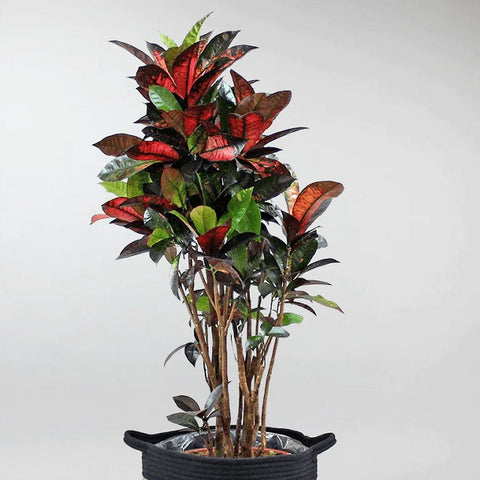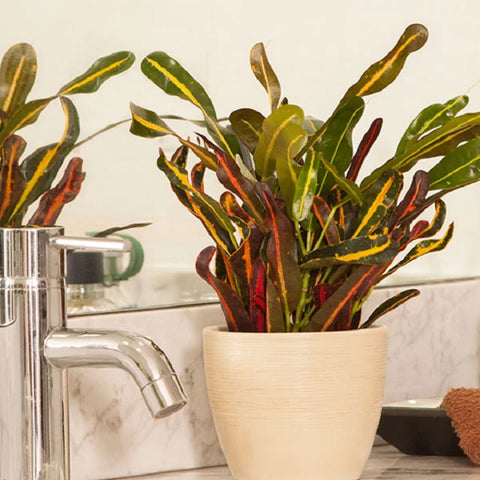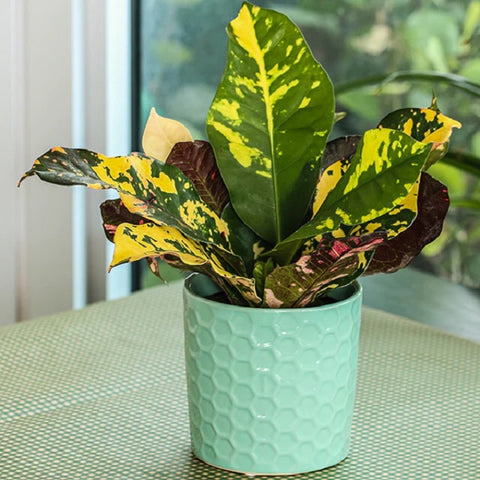Your Cart is Empty
Croton plants, known for their vibrant and colorful foliage, are a fantastic addition to any indoor or outdoor garden. Native to Southeast Asia, these tropical plants have become popular ornamental choices due to their stunning and varied leaf colors. In this comprehensive guide, we'll explore everything you need to know to successfully grow and care for Croton plants.
Let's dive into the details of each section to help you become a Croton plant expert.
Croton plants, scientifically known as Codiaeum variegatum, originate from the lush tropical rainforests of Southeast Asia. They have also found their way to parts of Australia and the Pacific Islands. These plants are celebrated for their striking and multi-colored foliage, which can feature shades of green, yellow, orange, red, purple, and pink.
With over 100 different varieties, Croton plants offer a wide range of colors and leaf shapes. Here are some of the most common varieties:
- Petra Croton (Codiaeum variegatum 'Petra'): Known for its bright red and yellow foliage.

- Gold Star Croton (Codiaeum variegatum 'Gold Star'): Features bright yellow leaves with green veins.

- Mrs. Iceton Croton (Codiaeum variegatum 'Mrs. Iceton'): Exhibits variegated foliage in shades of green, yellow, orange, and red.

- Lauren's Rainbow Croton (Codiaeum variegatum 'Lauren's Rainbow'): Offers a spectrum of colors, including green, yellow, orange, red, and purple.

- Magnificent Croton (Codiaeum variegatum 'Magnificent'): Boasts large, oval leaves with hues of green, yellow, orange, and red.

Croton plants thrive in bright, indirect light. While they can tolerate some direct sunlight, too much sun exposure can lead to leaf scorching. Therefore, placing your Croton in a location with filtered or indirect sunlight is ideal. East or west-facing windows are often suitable options.
These tropical beauties prefer warmer conditions, with an ideal temperature range of 65-75 degrees Fahrenheit. They also enjoy a humid environment. If your home's air is dry, consider misting your Croton plant regularly or placing it on a pebble tray filled with water to increase humidity.
Crotons prefer well-draining potting mix. You can use a commercial potting mix or create your own by combining equal parts of peat moss, perlite, and vermiculite. Well-draining soil helps prevent waterlogged roots, a common cause of problems in Croton plants.
To encourage healthy growth, fertilize your Croton plant every two weeks during the spring and summer months with a balanced fertilizer diluted to half strength. However, avoid fertilizing in the fall and winter.
Regular, but not excessive, watering is key to Croton plant care. Allow the top inch of soil to dry out between waterings. Overwatering can lead to root rot, which is a common issue with these plants. Consistency in your watering schedule is crucial.
Regular pruning is essential to remove dead or dying leaves and to shape your plant. This helps maintain the plant's overall health and appearance. Pruning can also stimulate new growth and branching.
Croton plants are vulnerable to various pests, including scale, mealybugs, and spider mites. If you notice any of these pests on your plant, isolate it from other plants and treat it with insecticidal soap or neem oil. Here's how you can manage these pests using different methods:
- Organic Pest Control: To combat scale insects organically, a mixture of neem oil and water can be effective. Neem oil is derived from the neem tree and is a natural insecticide. Mix a few drops of neem oil in water and apply it to the affected areas using a spray bottle. Repeat this treatment every 7-10 days until the scales are under control.
- Chemical Pest Control: In cases of severe infestations, you might consider using chemical pesticides. Insecticides designed to treat scale insects often contain active ingredients like imidacloprid, acetamiprid, or thiamethoxam. These chemicals are neonicotinoids, which target the nervous systems of insects, including scale insects.
- Biological Pest Control: One natural way to control scale insects is by introducing beneficial insects like ladybugs or lacewings. These predators feed on the scales, helping to keep their population in check.
- Organic Pest Control: Mealybugs can be managed with organic solutions, such as a mixture of water, liquid soap, and alcohol. Combine a few drops of dish soap and alcohol in water, then spray this solution on the mealybugs. Be cautious not to oversaturate the plant. Repeat this treatment every 7-10 days until the infestation is controlled.
- Chemical Pest Control: For severe mealybug infestations, chemical pesticides designed to target mealybugs can be used. Common active ingredients for controlling mealybugs include imidacloprid, thiamethoxam, and clothianidin (neonicotinoids). Additionally, insecticides with ingredients like pyrethroids (e.g., pyrethrin) and organophosphates may also be effective.
- Biological Pest Control: You can also introduce natural predators like parasitic wasps, ladybugs, or lacewings to your garden, which will help reduce the mealybug population.
- Organic Pest Control: A mix of water and liquid soap can be used to control spider mites organically. Ensure the solution reaches the undersides of the leaves where spider mites often hide. Repeat this treatment every few days as needed.
- Chemical Pest Control: Chemical pesticides designed for spider mites are available and can be applied when infestations are severe. Miticides are specifically designed to target spider mites. They contain active ingredients such as abamectin, bifenazate, hexythiazox, and spiromesifen. These chemicals disrupt the mites' nervous systems or metabolic processes.
- Biological Pest Control: Predatory mites are a biological control option for spider mites. These beneficial mites feed on the pest mites, helping to keep their population in check. Introducing predatory mites can be an effective, long-term solution to spider mite problems.
It's important to monitor your Croton plants regularly for signs of pest infestations, such as discolored leaves or the presence of pests themselves. Taking early action is key to managing these pests effectively and preventing them from causing extensive damage to your plants. Always follow the instructions on any pesticide or treatment product and consider using the least toxic methods first, such as organic and biological controls, to minimize the impact on your garden's ecosystem.
Croton plants can be propagated from stem cuttings. To propagate your Croton:
- Take a cutting from a healthy stem.
- Place the cutting in a container with moist potting mix.
- Keep the soil consistently moist and provide indirect light.
- Roots should develop in a few weeks, and once the plant has established roots, you can transplant it into a larger pot.
Propagation is a great way to share the beauty of Croton plants with friends and family.
Here are some common problems you might encounter when growing Croton plants and how to address them:
- Leaf drop: Leaf drop can result from overwatering, underwatering, insufficient light, or pests. Check the soil's moisture level, ensure proper lighting, and inspect for any pests or diseases.
- Yellow leaves: Yellowing leaves can be a sign of nutrient deficiency or excessive direct sunlight. Adjust your fertilization schedule and consider moving your plant to a shadier location.
- Brown leaf tips: Brown leaf tips may indicate low humidity or overwatering. Mist the plant more frequently, relocate it to a more humid area, and reduce watering.
- Pests and diseases: Croton plants can be susceptible to pests like scale, mealybugs, spider mites, and fungal diseases. Isolate affected plants and treat them with appropriate pesticides or fungicides.
Once you've mastered the basics, you can take your Croton plant care to the next level with these advanced tips:
Fertilization Tips: Crotons are heavy feeders, especially during the growing season. Use a balanced fertilizer diluted to half strength and apply it every two weeks in the spring and summer.
High Humidity Needs: Since Crotons hail from tropical rainforests, they appreciate high humidity. In dry indoor environments, mist your Croton plant regularly or place it on a pebble tray filled with water.
Protecting from Drafts and Extreme Temperatures: Crotons are sensitive to drafts and extreme temperatures. Avoid placing your plant in drafty areas or near heating or cooling vents. During winter, bring your Croton indoors if you live in a cold climate.
Pruning Techniques: Pruning can be performed year-round, but it's most effective during the spring and summer. Regularly prune to remove dead or unhealthy growth and to maintain the desired shape of your Croton.
Croton plants are not only visually stunning but also versatile in how you can incorporate them into your home and life.
- Home Decor: Place your Croton in a prominent spot to showcase its beauty. They make excellent accent plants for living rooms, dining rooms, and offices.
- Using Croton in Combination with Other Plants: Create a lush and inviting atmosphere by pairing Crotons with other tropical plants like palms, ferns, and orchids.
- Croton Plants as Gifts: Consider gifting a Croton plant to a friend or loved one. They make popular and thoughtful gifts for various occasions.
With proper care, your Croton plant can thrive and provide you with many years of enjoyment. Whether you're a seasoned gardener or just starting out, growing and caring for Croton plants can be a rewarding and visually appealing experience. By following the guidelines in this comprehensive guide, you'll be well on your way to becoming a successful Croton plant enthusiast.
Comments will be approved before showing up.
